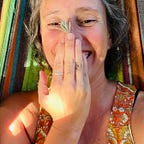Infographic and Story of the Portuguese Forest
The Three Ladies
There on the top of the hill, among the rocks, right at the edge of the spring, lived three Ladies. They danced under the moon and the stars, waving in the wind melodies. They had grown up there, the three sisters intertwined. They talked to the freshwater flowing from the earth’s belly; they listened to the birds and animals that lived there. They courted the fungi that emerged from their bodies. They hugged each other under the ground during the spring storms. They sheltered in the cold of winter, and the spring water soaked their roots in the heat of the hot days.
Many seasons have passed, and their trunks thicken with deep furrows of stories to tell. Old hands, now made humus, had long ago sown and tended them. Together they grew, embraced by the roots and intertwined by the tops, there at the edge of the spring.
The three sons of the man who sowed them inherited the Dancing Beeches. Out of mist and greed, for he had never seen them dance, the eldest son soon cut down one of the Ladies to use its wood. The deaf cries of his sisters tried to prevent the worst, hitting him with twigs and branches. But the man insisted, and the sister’s body fell, still alive, on the stone floor. Thanks to the village men, they cut off her torso and dragged the pieces away before the distressed presence of her grieving sisters. Together in their pain, they called on the wind, which raised a storm. The men fled, saying that the place was cursed.
People stopped coming there. A few years passed, and the two Ladies started dancing again despite the pain and grief over their sister’s loss. Their whole woody, tree-like bodies vibrated and resonated with the elements, and they danced to the rhythm of life around them. But the summers began to heat up, and in one of those hot, dry seasons, the spring ran out. The water evaporated, and of the whispers of water, only the memory remained. The voracious and blazing fire seized the opportunity and swept through the area. Surprisingly, two brothers appeared and took care to extinguish the flames, and the two Dancing Beeches, frightened and covered in ash, survived. But so did the torrid, dry days. One of the two sisters began to dry up, its leaves turning yellow and falling off. She became rigid and could no longer dance. It shriveled, withered. Dried up. She was standing but lifeless. Eventually, it tumbled over, and the last Lady heard its fall, smelling of sadness and longing in its woody heart.
Many seasons passed, several storms howled, and the Lady no longer had anyone to hold her roots. But her trunk had grown as the canopy reached higher and the roots went deeper. Her shade sheltered many burrows, nests, and nests. Her body harbored and nurtured life. And she danced again. On full moon nights, the village children would see her there on top of the hill, moving by the blows of the wind, dancing under the moon and the stars.
After a few cold and rainy winters, fresh water poured back from the spring, and little shoots emerged from the stony ground. New hands tended them, and so they grew. Young Beeches, accompanied by the last Lady, continued to dance, who taught the little sprouts this place’s rhythms and the old stories. She told him the stories of her sisters, how they danced together, and of the human hands that both care and destroy. At the end of her days, her body lay on the ground in the shade of a forest of Beech, Chestnut, and Oak trees, right there at the edge of the spring.
We have arrived here in the 21st century, and we understand that the crisis is one of perception of the forest as just a resource, of the illiteracy of confusing monoculture with a forest full of biodiversity.
This infographic only reaches the 15th century, not even close to the monoculture and mining policies of the late 20th century. It serves as a basis for understanding that it is not a question of forest management but of the understanding that it is a forest. When it is silenced as an inert resource for exclusively human use, it is emptied by our own hands. In the necessary great cycles of regeneration, only the stones can witness a change.
References:
- https://www.publico.pt/2017/12/09/ciencia/noticia/como-se-extinguiu-o-ursopardo-em-portugal-1795132
- Jorge Paiva — “A relevância da fitodiversidade no Montemuro”
- Francisco Álvares e José Domingues — “PRESENÇA HISTÓRICA DO URSO EM PORTUGAL E TESTEMUNHOS DA SUA RELAÇÃO COM AS COMUNIDADES RURAIS”
- M. T. ANTUNES — “Castor fiber na gruta do Caldeirão, Existência, distribuição e extinção do castor em Portugal”
- Nicole Devy — Vareta — “Para uma geografia histórica da floresta portuguesa, AS MATAS MEDIEVAIS E A «COUTADA VELHA» DO REI”
- Nicole Devy — Vareta — “Para uma geografia histórica da floresta portuguesa, DO DECLÍNIO DAS MATAS MEDIEVAIS À POLÍTICA FLORESTAL DO RENASCIMENTO (séc. XV e XVI)”
